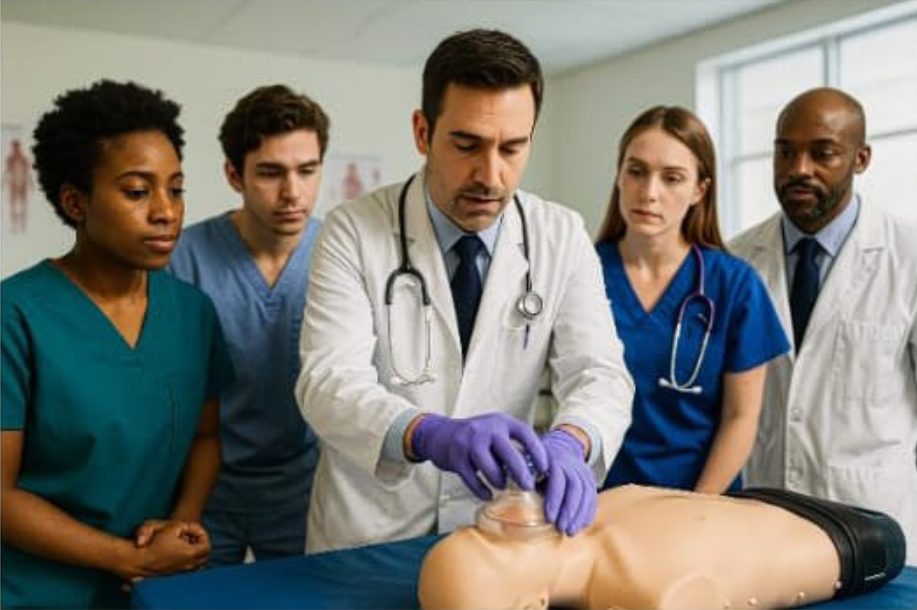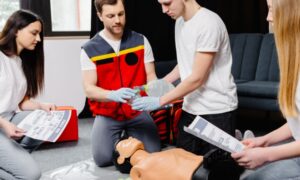Prioritizing Patient Safety
In healthcare environments, patient safety is paramount. While advanced medical technologies and treatments play a significant role in patient care, the ability to respond effectively to emergencies is equally crucial. This is where First Aid training becomes invaluable. Healthcare professionals equipped with First Aid skills are better prepared to handle unexpected situations, ensuring the well-being of patients and fostering a safe environment. Whether it’s managing a sudden allergic reaction, addressing a fall, or providing immediate care before emergency services arrive, First Aid training is an essential component of comprehensive healthcare delivery. Healthcare institutions, hospitals, and clinics alike need to ensure that their teams are fully trained in First Aid to respond effectively in any emergency situation.

The Role of First Aid in Healthcare Settings
First Aid training encompasses a wide range of skills, each essential in healthcare settings. Whether it’s a small injury or a major emergency, having staff trained to administer First Aid can make a critical difference.
1. Immediate Response to Medical Emergencies
In healthcare environments, emergencies can occur without warning. A patient may experience a cardiac arrest, severe allergic reaction, or sudden injury. In these instances, the healthcare staff’s ability to respond quickly with CPR or basic first aid techniques can mean the difference between life and death. First Aid training ensures healthcare providers can stabilize a patient until further medical assistance can be provided.
For example, when a patient goes into cardiac arrest, every minute without CPR reduces their chances of survival. CPR and First Aid training teach healthcare professionals the necessary skills to respond immediately, minimizing harm and keeping the patient stable.
2. Managing Minor Injuries
Healthcare environments are full of potential hazards. Whether it’s from handling sharp instruments in surgery or performing regular procedures, injuries such as cuts, bruises, or burns are common. First Aid training enables healthcare providers to address these injuries promptly, reducing discomfort and preventing further complications. This is particularly important in fast-paced or high-stress situations, where time and efficiency are critical.
3. Supporting Mental Health Emergencies
First Aid training isn’t just about physical injuries. Mental health emergencies are also a concern in healthcare settings, especially with the high levels of stress and emotional strain that patients may experience. Many organizations are incorporating mental health First Aid into their training programs. This includes recognizing signs of mental health crises, such as anxiety attacks, depression, and suicidal ideation, and providing appropriate support until a mental health professional can step in.
Healthcare professionals trained in mental health First Aid can intervene early, offering crucial support and making referrals for further care.
Benefits of First Aid and CPR Training for Healthcare Professionals
The advantages of First Aid and CPR training extend far beyond emergency preparedness. Here are some key benefits:
1. Improved Patient Outcomes
The primary benefit of First Aid and CPR training is the direct impact it has on patient outcomes. Studies have shown that timely intervention by trained healthcare professionals can reduce the severity of injuries and prevent fatalities in emergency situations. In critical moments, knowing how to administer CPR, stop severe bleeding, or perform other life-saving techniques can improve a patient’s chances of survival and recovery.
2. Increased Confidence and Preparedness
Healthcare professionals who are trained in First Aid and CPR tend to feel more confident in their ability to handle emergencies. This confidence translates into a calm, measured response, even in high-stress situations. When professionals know what steps to take, they can react quickly and effectively, improving overall patient care.
Additionally, well-prepared staff reduces the overall stress in the workplace. Healthcare workers can focus more on patient care, knowing that they’re ready to handle any situation that may arise.
3. Compliance with Health and Safety Standards
In many healthcare environments, First Aid and CPR certification is a requirement for employees. Hospitals, clinics, and other healthcare organizations must meet health and safety regulations to ensure their staff is prepared for emergencies. Training in First Aid is often a legal requirement and helps healthcare providers comply with national and international health and safety standards, ensuring a safe and reliable environment for patients and staff alike.
4. Team Cohesion and Efficiency
When an entire healthcare team is trained in First Aid and CPR, there is better communication and coordination during emergencies. Everyone knows their role and how to contribute to resolving the situation. This teamwork can significantly improve the response time during critical emergencies, creating a more efficient and organized environment in healthcare settings.
Integrating First Aid Training into Healthcare Practices
Healthcare organizations should make First Aid and CPR training a core component of their professional development programs. To ensure the best outcomes, here are some recommendations:
- Regular Training and Refresher Courses: Healthcare professionals should participate in First Aid and CPR courses regularly to stay up to date with the latest practices. Refresher courses ensure that skills remain sharp, so staff members are always ready to act when necessary.
- Simulated Emergency Drills: In addition to classroom training, simulated emergency drills can help healthcare providers practice their skills in realistic scenarios. Drills can help staff work through different types of emergencies, from cardiac arrest to choking incidents.
- Create a Safety-Focused Culture: First Aid and CPR training should be viewed as an integral part of the healthcare environment. Building a safety-focused culture where staff members are empowered and encouraged to respond to medical emergencies can improve overall patient safety.
Conclusion: A Commitment to Patient Care and Safety
First Aid and CPR training are essential tools for healthcare professionals to provide excellent care. These certifications not only prepare staff to handle medical emergencies efficiently but also play a critical role in ensuring patient safety and improving outcomes. By integrating these skills into healthcare practices, organizations create a safer, more confident environment for both staff and patients. It is an investment in the quality of care provided, and most importantly, an investment in the health and well-being of everyone in the healthcare setting.


































